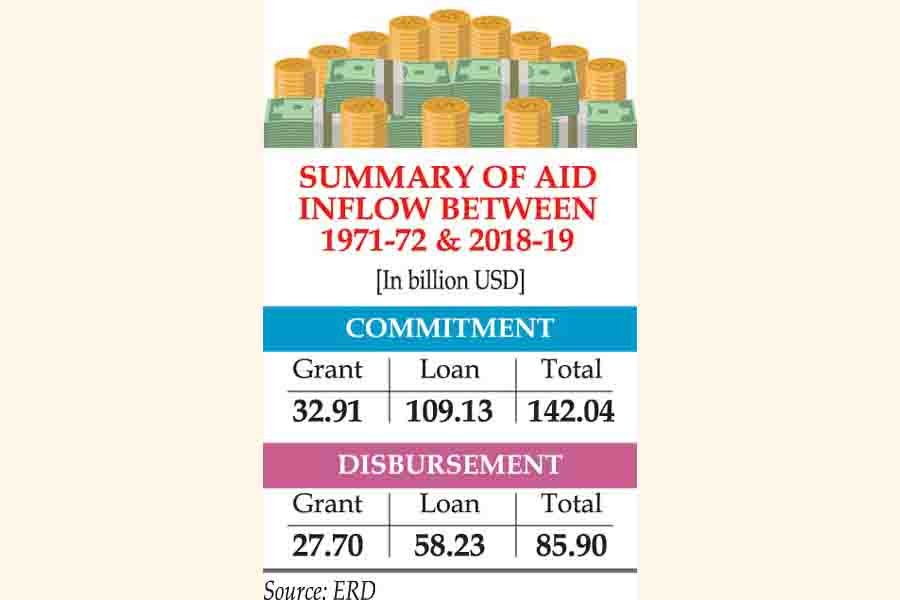
The two-day Bangladesh Development Forum (BDF) kicks off in the city today (Wednesday) after a gap of two years.
Government policymakers, private sector and civil society representatives, academicians and donor representatives will take part in the event, the Economic Relations Division (ERD) officials said.
Analysts said although the inflow long- and medium-term (MLT) concessional foreign assistance has increased, their size has shrunk in proportion to the country's gross domestic product (GDP).
The average annual inflow of foreign aid has been equivalent to around 2.0 per cent in recent years. It was more than 6.0 per cent a couple of decades ago.
The ERD officials said the Bangladesh government will apprise the development partners of its growing need for foreign investment to help spur the country's development process and eradicate poverty further.
Thirty years ago, in the fiscal year (FY) 1989-90, the share of foreign assistance in implementing Bangladesh's annual development programme (ADP) was 64 per cent of the total Tk 52.03 billion outlay.
However, the share of external assistance in the development programme has been shrinking continuously, and it has declined to 35 per cent in current FY, 2019-20.
Of the Tk 2.02 trillion ADP outlay for the FY '20, Tk 1.31 trillion, or 65 per cent, will be met with domestic resources. The rest of Tk 718 billion or 35 per cent will come from its external sources as project aid (PA).
The total size of foreign aid rose to nearly US$ 6.54 billion in last FY from a paltry amount of $ 270.80 million in FY 1971-72.
Earlier, the government used to seek specific aid commitments from the foreign development partners from the Aid Consortium, held in Paris, for improving the country's socio-economic condition and eradicating poverty.
Until 2001, Bangladesh took part in the Aid Consortium meetings, where it used to apprise the development partners of its need for investment in development works.
But from 2001, both development partners and the aid-recipient countries decided against the direct aid pledging. The Paris Declaration in 2005 gave the decision a concrete shape.
The theme of development and economic cooperation changed to "leadership and ownership". Under the theme, the aid-recipient countries present their development programmes before the donors, who, in turn, align their plans with the respective countries.
The BDF has been formed under the Local Consultative Group (LCG), a platform of the development partners working in Bangladesh.
The government and the LCG members take part in the BDF, where the government presents its development plans and programmes for short- to mid-term basis.
After joining the Aid Consortium for the last time in 2001, Bangladesh organised the first BDF in 2002. The second BDF was held in 2010, the third in 2015, and the fourth in 2018.
When asked about outcome of the previous BDFs, the ERD secretary said there is no concrete assessment on it until now.
"But as long as the government frames its development plans and programmes, and the development partners support those accordingly, we are on track of achieving our targets and goals to become a developed nation by 2041," he added.
Representatives from different donors will take part in the BDF 2020, including Senior Vice President of the Japan International Cooperation Agency (JICA) Junichi Yamada, Vice President of the World Bank (WB) South Asian region Hartwig Schafer, and Vice President of the Asian Development Bank (ADB) Shixin Chen, among others.
Meanwhile, Bangladesh received $ 3531 billion in loans and grants during the first five-year plan (FYP) of Bangladesh, implemented between FY 1974 and FY 1978.
During the second FYP from FY 1981 to FY 1985, the country received $ 6.08 billion in grants and loans.
Bangladesh got $ 8.0 billion during the third FYP from FY 1986 to FY 1990, some $ 7.30 billion during the fourth FYP from FY 1991 to FY 1996, some $ 7.16 billion during the fifth FYP from FY 1997 to FY 2002, and $ 12.82 billion during the sixth FYP.
During the ongoing or seventh FYP, the government has so far received $ 20.14 billion in the first four years from FY 2016 to FY 2019.
© 2024 - All Rights with The Financial Express
